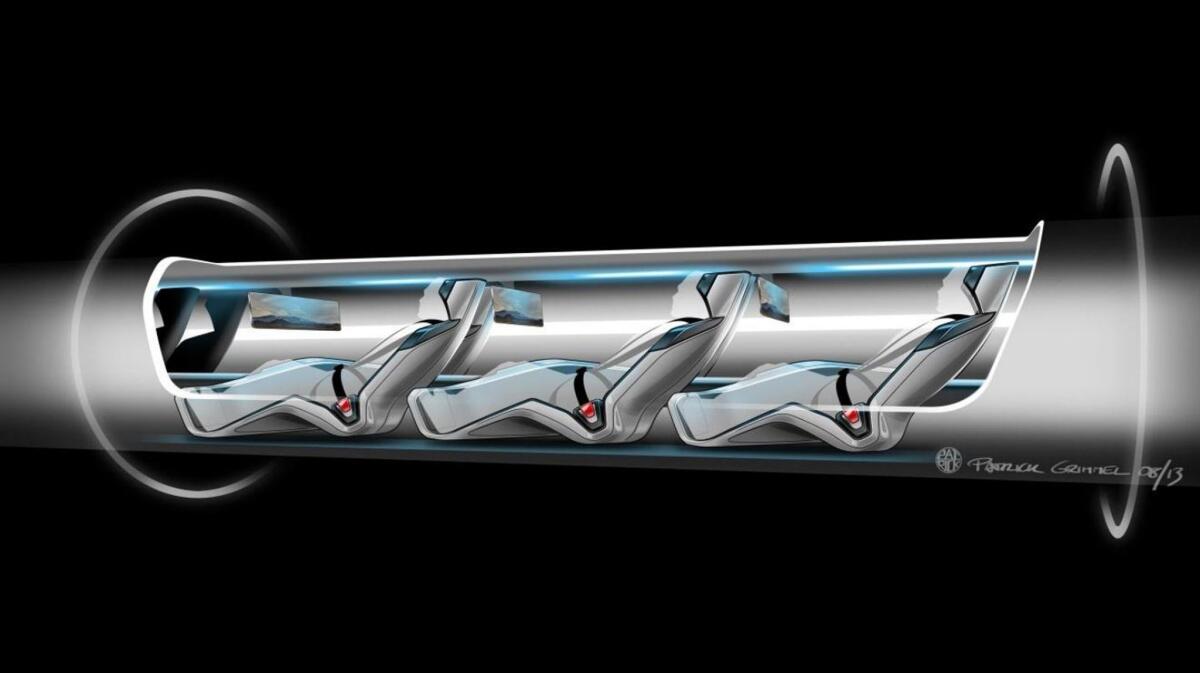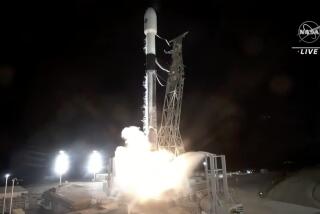SpaceX’s hyperloop student contest brings out many big benefactors

SpaceX and Elon Musk released conceptual designs for hyperloop pods a couple of years ago. Students get a chance to show off their designs this weekend.
- Share via
Elon Musk is bringing together more than 1,000 college and high school students this weekend to showcase passenger-compartment designs for a hyperloop high-speed transit system.
Two Los Angeles start-ups are already developing hyperloops, starting with test track construction in the Central Valley and North Las Vegas later this year. Driven by a possible mix of electricity, magnetism and air pressure, levitating hyperloop pods would zip fast enough through above-ground tubes to reach San Francisco from Los Angeles in 30 minutes.
But Musk, who popularized the concept three years ago, wants more people involved.
Last summer, the billionaire’s rocket company Space Exploration Technologies Corp. launched a student competition to design and build those pods. It includes design reviews Friday and Saturday at Texas A&M University and culminates with small-scale tests this summer near SpaceX in Hawthorne.
The SpaceX Hyperloop Pod Competition has more than 120 university teams and three high schools vying for runs inside the nearly mile-long, 6-foot-diameter steel-and-concrete tube that’s being planned.
Students said they recognized their projects might not be polished, but hope their ideas could still speed up the launch of a commercial hyperloop.
“No doubt there might be errors in everybody’s design, but it’s a start,” Cal Poly sophomore Wayne Page said. “Even if we don’t get any benefits, but the companies do, it’s still something gained by society as a whole. That’s probably the most exciting thing.”
More than that, the competition has led hundreds of companies, organizations and, of course, parents to contribute what could easily reach millions of dollars to hyperloop research. SpaceX hasn’t tracked teams’ expenses.
Building demo pods, as many teams hope to do, may cost as much as $100,000. Part of this weekend’s exercise is about soliciting cash from donors. Expected sponsors include engineering giant Aecom, law firm Cooley and TV network Nickelodeon. Musk is not expected to appear.
Hyperloop proposals call for the pod to be suspended in air to reduce friction and increase speed, but groups are split over whether to achieve that by using a stream of air underneath or pulsating the pod between magnets. The Cal Poly team went with the significantly more affordable though less tested option: air bearings.
Page has spent 100 hours over the last four weeks with 14 others to work out kinks. They’ve tapped Internet crowdfunding, family, school grants and their own bank accounts to fund the Texas trip. They’re bargain-hunting at every turn, flying ultra-low-cost carrier Spirit Airlines to get there.
It’s a similar story at UC Irvine, where 25 students working 40 to 50 hours a week on the hyperloop project have received $10,000 plus lab and office space from the university, free training from software companies such as Ansys and guidance from employees at corporations including Microsoft.
The key technologies Musk proposed for the hyperloop, including solar power and air compression, haven’t been mixed in such a complex machine before, forcing entrants to think creatively.
“In other senior design projects and annual competitions, you can look at last year and say, ‘What can we do better?’” UC Irvine senior Anthony Cirillo said. “We didn’t have that here. You can’t just go on the Internet and find the answers.”
A triple-redundant computer system and a redundant braking system are some of the reasons Irvine’s design should stand out, Cirillo said. He added that the team won’t disband until it produces a working model.
“If that means we have to kick up the sponsorship, then we can do that,” he said.
At El Segundo High School, five seniors are generating graduate-level work by designing custom intake valves and tubing to corral air slamming the pod’s nose, said teacher Steven Eno.
The school, parents and neighbors, including employees at a nearby Air Force base, have offered support to the tune of $14,000 and countless hours.
The high-schoolers said they’re nervous about presenting this weekend to judges from Musk’s companies and academia, but they’re eager to see how they fare compared with universities they’re hoping to attend. At the least, they’ve learned team coordination lessons that will long be valuable, said leader Gavin Glynn.
“We are trying to be inspiration for other people in engineering classes or engineers in general to do something big and try something they might not have tried: ‘There’s a high school team doing that, imagine what we could do as well,’” he said.
Chat with me on Twitter @peard33







